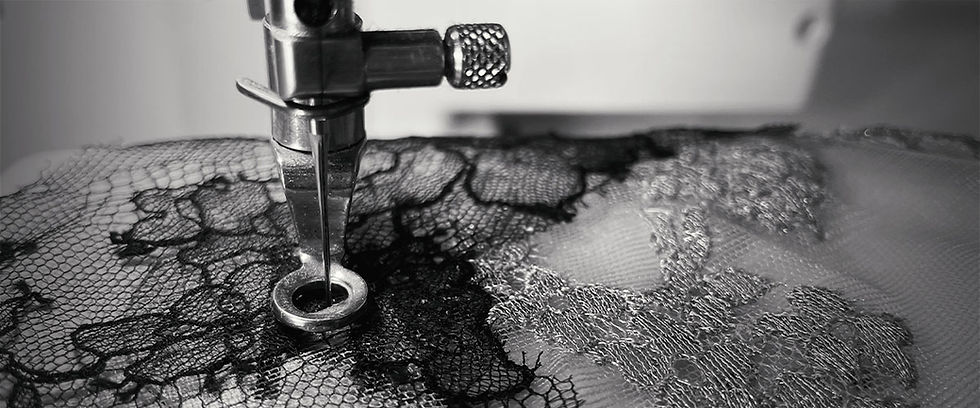Contouring: Lace Edition ~ How our unique Lace Appliqué Patterns come to Life
- celine6195
- May 30, 2022
- 3 min read
Updated: Jun 20, 2022
My life long fascination for textures, whether found in nature, architecture or living beings, has always inspired me to experiment with textiles and create my own unique surface designs. Rather than using materials in their original form, I love to deconstruct and merge materials with different haptics and aesthetics, creating an entirely new experience of the fused elements.

My love for traditionally made French leavers laces naturally lead me to apply thus techniques on the lingerie I create and quickly established itself to become my signature aesthetic. Rather than using laces in their original state which is continuous meterage, I hand select areas of the floral patterns and create my own mosaic of decor which is finely stitched on an ultra fine and sheer illusion mesh creating our iconic ‘tattoo lace’ look. Despite it being a very time consuming procedure, I truly love its reward as it opens up an endless array of design possibilities and enable me to create truly unique one-off creations. Allow me to introduce you to the full process of creating our unique appliqué patterns below.

It all begins with mapping out the areas of the original lace fabric that will be used by roughly cutting out the wanted flower clusters. As the exact patterns cannot be precisely cut out just yet, it is truly important to be able to visualise the final outcome beforehand, both through creativity and experience.

Rather than placing the lace pieces on the flat mesh pattern piece, I always drape my patterns whilst putting the base garment on the mannequin. Witnessing how the lace drapes and behaves around the female curves truly refines the positioning and helps to create patterns that sit in dynamic harmony with the body. When creating more complex designs like elaborate body suits that feature a vast amount of appliqué in multiple colors, it is even necessary to allow multiple reviews on the mannequin throughout the process of attaching the lace.

Once the lace shapes have been positioned and pined onto the sheer ground, the contouring can begin. This process allows to securely attach and refine the pattern by fixating all contours with a tiny and narrow zig zag stitch. This is done on a specialist free-hand appliqué machine using an ultra thin thread specifically designed for this method. It allows to move and tilt the material freely underneath the needle to follow an individual and irregular pattern. Machine application also allows more resistance towards wear and tear and prevents the knitted material from easily unravelling in comparison to hand sewing.

This concludes the finishing touch of the application process: trimming back all excess material outside the stitched contour lines to create a crisp and defined outline. This is where the 'tattoo lace' effect truly comes to life for the first time. Before completing the appliqué process, I always review the final design on the dress form to be able to judge whether any areas need additional refinement through adding last appliqué pieces, almost like completing a mosaic.

A true couture garment is only as beautiful on the outside as it is on the inside. Therefore, a crucial last step is also to turn the garment inside out and review the inner layer of the stitches which sits directly against the skin. These should look like a continuous narrow outline smoothly contouring every outline of the design. It is the best way of reviewing the density of the stitch and determine possible areas that need reinforcement such as the top central connecting lines in the photograph above.
I hope you enjoyed this detailed insight into one of my most sacred and loved techniques. If you wish to learn more about my creative vision and expertise, visit the World of Hervé Section on our site.

Comments